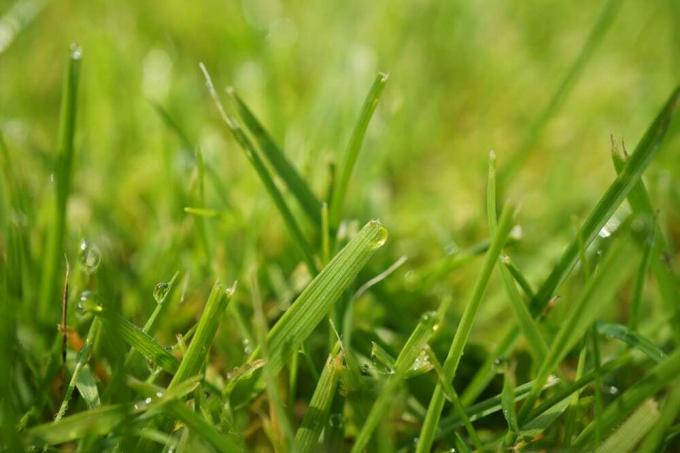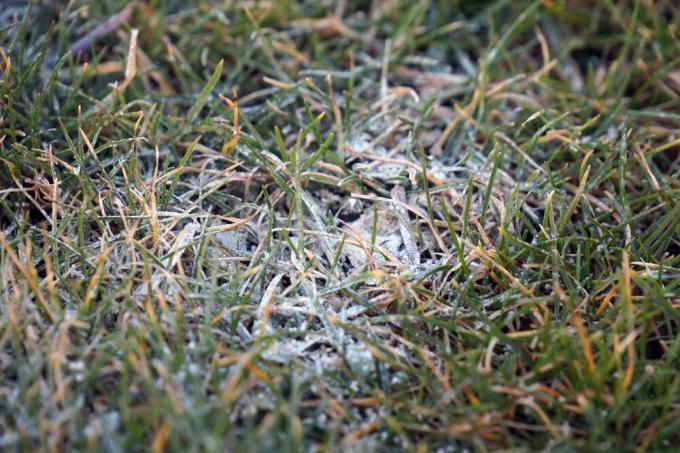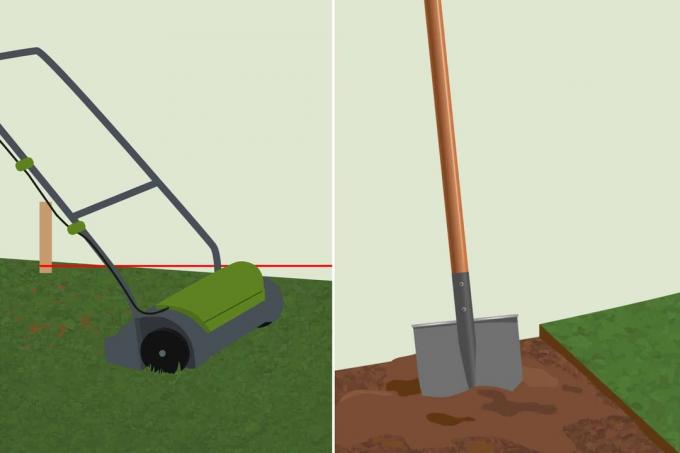

Table of contents
- Characteristics
- time
- temperature drop in autumn
- daytime weather
- Fertilize
- Patent Kali
If the lawn is lush green and strong stalks, the heart of the hobby gardener will be happy. To keep it that way, the greenery in the garden should also be fertilized regularly. In spring and summer this is a matter of course. However, autumn fertilization is rather unusual in this country. It supplies the blades of grass with important nutrients before the cold season and helps them survive the cold season.
Characteristics
Special fertilizers called Autumn fertilizers have a composition that meets the lawn requirements during the cold season because they are characterized by a high proportion of potassium and phosphate. Potassium acts like a natural antifreeze, because potassium increases the salt concentration in the plant cells, which lowers the freezing point of the plant sap. This makes the stalks more resistant to frost and cold. Phosphate helps the roots to survive the cold season. The autumn fertilizer should also have the following properties:
- high proportion of minerals and trace elements
- good long-term effect
- Minimizing the risk of fungal infection (snow mold)
Under no circumstances should you apply a fertilizer in autumn that has a high proportion of nitrogen, as this stimulates the growth of the blades of grass. However, this is counterproductive in autumn, since the weather conditions are not ideal for growth. Only soft stalks grow back, which are more susceptible to diseases and do not tolerate frost and cold well.
time
When is the right time to apply the autumn fertilizer depends on the weather conditions and the region. Since the blades of grass only absorb the fertilizer while they are growing, lawn growth is the decisive criterion when it comes to fertilizing. The culms grow when the temperature is above five degrees Celsius. If it falls below that, they stop growing. Therefore, to determine the optimal time for autumn fertilization, the horse must be put before the horse, proverbially.
In Germany, the five-degree limit is usually reached in October or reached Nov. A look at the temperature profile for your region in recent years will help you narrow down the period. Once it has been clarified, you should allow three to four weeks for the fertilizer to absorb. So if the five-degree mark is in November, the autumn fertilizer must be applied in October. If it is in October, then the autumn fertilization falls in September.
Tip:
Some also set the growth limit at ten degrees Celsius. In this case, the output of autumn fertilizer will be postponed accordingly.
temperature drop in autumn
Unfortunately, you can no longer trust the weather, especially in recent years. A cold snap in October and a relatively warm November must be expected. In order to be prepared for such a sudden drop in temperature in October, you can start autumn fertilizing earlier, i.e. in September.
daytime weather
In addition to the time on the calendar, you should also pay attention to the weather of the day. Regardless of whether you use a liquid fertilizer or a granular fertilizer, you should not fertilize on a sunny autumn day. Because the sun's rays break the irrigation water, and this can lead to burning of the blades of grass. This also applies to granular fertilizer, since the lawn must be watered after it has been dispensed.
Take advantage of forecast rain. So you can spend the autumn fertilizer when rain is forecast for the next day or the evening hours. In this case, the rain takes over the watering. If you leave the watering to the rain, it can take three to four days, depending on the intensity of the rain, for the granules to disappear into the ground. Therefore, a weather situation that promises several rainy days is optimal in this case.
Fertilize

If the right day for the autumn fertilization has come, the green must not be over-fertilized. Therefore, you should stick to the amount indicated on the bottle or bottle. hold the pack. When using a granular fertilizer, you should ensure that the granules are evenly distributed over the lawn. A spreader will help you with this. In this way, even tracks can be drawn and the granulate is evenly distributed over the lawn.
Tip:
Make sure that the tracks do not overlap.
In places that are difficult or impossible to access with the spreader, the granulate fertilizer is distributed as evenly as possible by hand. Liquid fertilizers are easier to use because they are simply added to the irrigation water. However, they are only recommended for smaller lawns, as watering large areas can easily become a tedious task.
Patent Kali
Patentkali, also known as potassium magnesia, is a cheap alternative to autumn lawn fertilizers because, like these, it increases the winter hardiness of the lawn. It contains 30 percent potassium, 10 percent magnesium and 15 percent sulfur. So that Patentkali can develop its full effect, it should be spent during the growth phase. The lawn can still absorb the fertilizer well. Administration in the months of September and October is recommended. The optimal dose is 70 grams per square meter of lawn.
Patentkali is issued in the same way as for autumn fertilizers. Here, too, you should pay attention to the daily weather and apply the fertilizer evenly.
 garden editorial
garden editorial I write about everything that interests me in my garden.
Learn more about lawn care

Leveling out unevenness in the lawn: this is how it works
Unevenness in the lawn is annoying and poses a danger to gardeners, playing children and pets. There are a number of methods that can be used to level the lawn. We present them to you in our guide.

Leveling the lawn: how to smooth uneven surfaces
Dents and holes in the lawn are unsightly. We will show you step by step how to smooth uneven areas in the lawn again.

Algae in the garden | Lawn is slippery: what to do?
Algae love rainy days. Can the water seep badly into the ground, even better! The green, slippery mass is not only not a pretty sight, but also a danger for the lawn. Only those who act preventively and correctly in acute cases can avoid permanent damage.

Fighting fungi in the lawn | 10 tips against fungal infestation
Mushrooms in the lawn are not uncommon but annoying and sometimes even dangerous. This is especially true if the garden or green space is also used by pets and children. Here we will show you how to combat fungal infestation.

Aerate the lawn | Before or after mowing?
Sun, water, fertilizer and air are necessary for the lawn to grow. If the lawn does not get enough air, it cannot grow properly. We clarify when the right time to ventilate the lawn is.

Mulching with lawn clippings: 13 things to consider
Keeping the lawn short is a must for many hobby gardeners. However, if the lawn mower does not have a mulching function so that the grass clippings can remain on the lawn, the question arises as to where to put the waste. Because the compost heap is not a good solution here.
